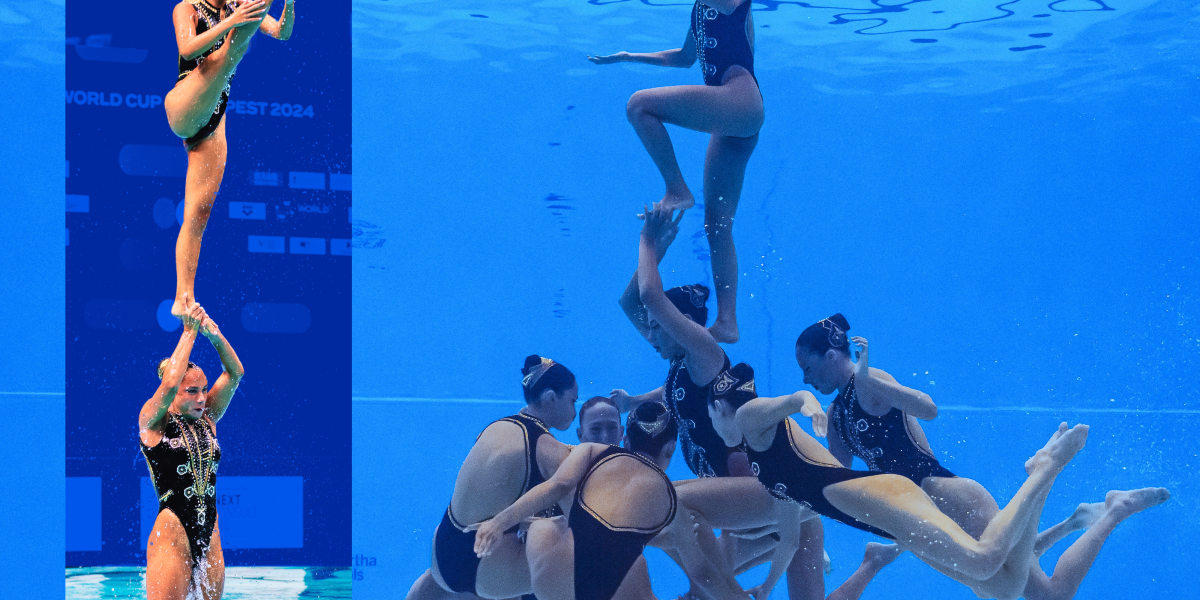While a lot of people think artistic swimming is delightfully antiquated—a bunch of “bathing beauties” in floral swim caps and cherry-lipped smiles—that idea is a tired old stereotype that Daniella Ramirez, a Team USA artistic swimmer set to compete at the 2024 Olympic Games, is sick of hearing. She’s amassed a TikTok following with her post-performance, ASMR-esque “get unready with me” videos, and she’s hoping her content ultimately brings more attention to, and respect for, a grueling (sometimes dangerous) sport she’s spent her entire life—quite literally, her mom and grandmother were athletes too—perfecting.
Ramirez recently spoke with SELF on what it takes to compete in artistic swimming at an Olympic level; why she’s tired of misogynistic, sexualized associations of the sport; how scary being inverted underwater can actually be; and other things she wishes more people knew.
SELF: In artistic swimming, there’s so much emphasis on artistry and beauty—in a predominantly female sport. Do you sometimes feel like outsiders don’t take it as seriously as they should because of this?
Daniella Ramirez: I feel like my goal as a content creator has always been to make our sport more respected and put it in the limelight—to show people how hard it actually is. People tend to associate artistic swimming with Esther Williams, or women diving into a pool sideways in a line. It’s always super hypersexualized, or we’re in the back just being pretty. It’s not like that. We’re not showgirls who touch the bottom of the pool, put an arm and a leg up, and look good. I think it’s very frustrating for me to talk about because it’s so ingrained into American Hollywood that synchronized swimming is background dancing for a pool party. There are a lot of misconceptions there.
Team USA, including Daniella Ramirez, competing at the Doha 2024 World Aquatics Championships.
Maddie Meyer/Getty Images
So that’s one common misconception about artistic swimming—that you can stand on your feet underwater during competition?
People always think we touch the bottom, but I have never, ever touched the bottom of the pool in a routine, ever. What’s another good misconception? The freaking flower caps. Can we end it with the flower caps? Please put that in there. Please end flower caps.
Aside from old sexist media associations, why do you think some people have such a misunderstanding of the sport?
When you look at someone like Simone Biles, I feel like it’s easier to comprehend just how hard her sport is because it’s on land, and we know how physics works. A lot of people tend to think swimming itself is easy, but it’s super hard as it is. Now instead of swimming back and forth, imagine going up and down too, and treading water. That’s artistic swimming.
In Paris, you and your teammates will be in the pool competing for roughly three to three-and-a-half minutes at a time (on three consecutive days). How long does it take to prepare for these performances?
Leading up to the competition, we are training in the pool for about two hours a day, three days a week, for one performance. But that’s just time in the water—we do a ton of other workouts, like CrossFit, but with our mouths taped to help with breath control since we’re underwater so much. We want to make sure that our lungs are really, really strong. We also do a lot of weight training with high reps and pretty low weights. Long before a competition, we’ll also do normal swimming—we’ll swim laps for three hours a day at some points.
Team USA, including Daniella Ramirez, competing at the Doha 2024 World Aquatics Championships.
Quinn Rooney/Getty Images
Speaking of your breathing, you and your teammates spend a *lot* of time underwater—sometimes half of your performance! Has it gotten easier over the years as you’ve grown in your sport?
